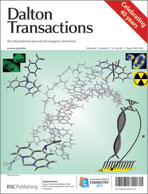Solvothermal reactions of Co(II), Ni(II), Zn(II) salts with 2,2′-dinitrobiphenyl-4,4′-dicarboxylate (dnpdc) and 2,2′-bipyridyl-like chelating ligands yielded five compounds formulated as [Co(dnpdc)(bipy)]n·nH2O (1), [M(dnpdc)(phen)]n (2, M = Co; 3, M = Ni; 4, M = Zn) and [Co(dnpdc)(biql)]n·2nH2O (5) (bipy = 2,2′-bipyridine, phen = 1,10-phenanthroline and biql = 2,2′-biquinoline). With bipy or phen as coligands, compounds 1–4 exhibit isomorphous 3D M(dnpdc) metal–organic frameworks in which double carboxylate bridged chains are interlinked by the backbones of the dicarboxylate ligands. The bipy or phen ligands are involved in interchain hydrogen bonding or π–π interactions to form 1D zipper-like arrays in the rhombic channels of the frameworks, playing a templating role and determining the channel dimensions. The biql coligand is too bulky for the 1D double carboxylate bridged chain and the rhombic channel. Instead, in compound 5, the dnpdc ligands link metal ions into 1D zigzag metal–organic chains and the biql ligands are arranged into 2D (6,3) arrays through extensive π–π stacking interactions. In compounds 1–3, the double carboxylate bridges in the nonplanar syn-skew conformation mediate ferromagnetic interactions along the chains, while the chelating ligands provide supramolecular pathways for interchain antiferromagnetic interactions. The π–π interactions in 5 also evoke weak antiferromagnetic interactions.


 Please wait while we load your content...
Please wait while we load your content...